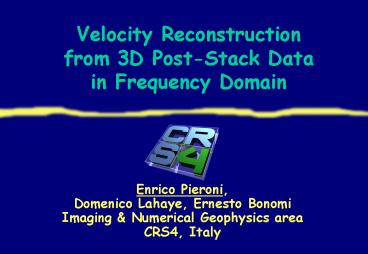Velocity Reconstruction from 3D Post-Stack Data in Frequency Domain - PowerPoint PPT Presentation
Title:
Velocity Reconstruction from 3D Post-Stack Data in Frequency Domain
Description:
Title: Inversion of Zero-Offset Seismic Data in the Frequency Domain Subject: Progetto Agip4 Author: Ernesto Last modified by: ep Created Date: 10/25/2000 3:47:24 PM – PowerPoint PPT presentation
Number of Views:80
Avg rating:3.0/5.0
Title: Velocity Reconstruction from 3D Post-Stack Data in Frequency Domain
1
Velocity Reconstruction from 3D Post-Stack Data
in Frequency Domain
- Enrico Pieroni,
- Domenico Lahaye, Ernesto Bonomi
- Imaging Numerical Geophysics area
- CRS4, Italy
2
Non-linear inversion of post stack data for
velocity analysis
- Subsoil imaging by inverting Zero-Offset seismic
data in space-frequency domain - Optimal control of the error norm between real
and - simulated data
- direct problem modeling by demigration
- adjoint problem error residual migration
- minimization line search along the error
gradient in the velocity space - A sequence of nested non-linear inversions, from
the - lowest to the highest frequency
- Algorithm embarassingly parallel in frequencies
3
What are post-stack data?
Offset acquisition Hundreds of shots
Thousands of receivers Stacking compression
of data to virtually zero-offset traces
(SG). Model exploding reflectors with halved
velocities
4
Direct Problem in the w Domain
Demigration mapping q(n) ? P(0) final value
problem in which the zero offset data are modeled
from medium reflectivity
- P(n) acoustic wave field at depth z(n)
(n-1)Dz - D(n) upward propagator
- v(n)(x) v(x, y, z(n)) velocity field
- q(n) normal-incidence reflectivity
Eqns decoupled in frequencies embarassing data
parallelism
5
Upward propagator
Scalar wave equation ? UPWARD DOWNWARD
separation Upward propagate data from reflectors
to surface with halved velocity one way wave
equation
Laterally invariant velocities
FFT Fourier matrix (x,y) -gt (kx,ky)
for laterally variable velocities
V(n) medium velocity at depth n
PS exact vel. normal prop.
correction
6
Build reflectivity from v
Due to orthogonal incidence velocity isosurfaces
?? reflectors
- gradient filtering
- Edge detection for IP
7
Minimization Problem Optimal Control Approach
- Find velocity v minimizing the misfit function j
- S Z.O. known data
- P(0) Z.O. simulated data ( field P _at_
surface)
- Constrained minimization Lagrange multipliers
method
8
Adjoint Problem in the w Domain
dL/dP(n) 0 Migration mapping initial value
problem (if misfit 0 then l 0)
- l(n) adjoint wave field at depth z(n)
(n-1)Dz - D adjoint operator, downward propagator D
9
Building the gradient
Constraining l(n) and P(n) to satisfy the direct
and the adjoint equation
from the first variation of the Lagrange
function
adjoint downward propagated DiffD direct
upward prop. field 0 if l0
10
Optimization strategy
- Number of parameters p NxNyNz 108 ? huge
search space no Hessian or Montecarlo work ?
lot of local minima ? Hessian evaluation
requires running p direct problems - Conjugate gradient to reduce computation,
storage and search time - - Gradient evaluated by automatic
differentiation - - CG orthogonal projection Vmin .LE.
v(x,y,z) .LE. Vmax - - conjugate directions build with
Fletcher-Reeves updating - Line search by Golden bracket Polynomial -
search interval bounded when the at least 1
velocity component reach the bound - Inversion adaptive in time-frequency to
stabilize solution
11
1D Test cases
1D is fully analytical both in the discrete and
in the continuum
- scissors ambiguity
- v(z) ? v(z) a v(z/a)
- ? Good 1st guess adaptive in freq.
12
Test 1 discontinuous velocitynf100 fmx50 Hz
13
Test 1
14
Test 2 continuous velocitynf100 fmx50 Hz
15
Test 3 disc. velocity inversionnf100 fmx50
Hz
exact
16
Test 3
0,50 Hz 200 itns
0,37.5 Hz 100 itns
17
Conclusion Further Developments
- Control of the error to decide how to proceed,
to be done automatically - Velocity estimate from the lowest to the highest
frequency (other sliding windows, back forth,
) , to be done automatically - Dev 3D feasible thanks to parallelization in
frequencies (3D should also remove a lot of
ambiguities) - Perspective integrate with a multi-scale
spatial approach from the lowest to the highest
depth - Dev correct ZO for geometrical spreading
amplitude - Open problem optimal tuning of the reflectivity
for real data
18
- THE END
19
Pragmatic inversion Migration
Downward propagate data at surface with halved
velocity
One way wave equation for laterally invariant
velocities
FFT Fourier matrix (x,y) -gt (kx,ky)
for laterally variable velocities
vj(n) reference velocities F shape functions
20
(No Transcript)
21
Goal subsoil imaging from post-stack data in
frequency domain determing the velocity model of
the subsoil in such a way that the simulated
(modeled) and measured (given) pressure field at
the surface (stacked sections) agree simulation
code - in frequency domain data compression
and hence reduced computational cost typical
problem dimension 500 MB - 1 GB direct/adjoint
propagation of data by phase shifting - in 3D -
highly innovative approach - weak points
reflectivity (isosurfaces of velocity
discontinuities) amplitude mathematical model
Lagrangian formulation - cost function
difference between simulated and measured
stacks - constraints one-way wave equation (in
frequency domain) - direct field demigration
(upward) from reflectivity to recorded data -
adjoint field migration (downward) driven by
source term (residual error) from surface data to
adjoint field - migration operator and
derivative - gradient Integral of (direct field
OP adjoint field) dx dy dz dw - weak points
computation of OP and gradient algorithm
projected CG (PCG) optimization for the velocity
model updating implementation Fortran90 MPI































